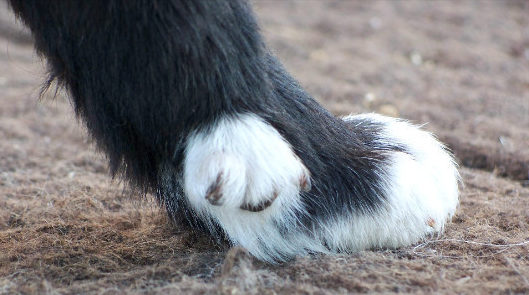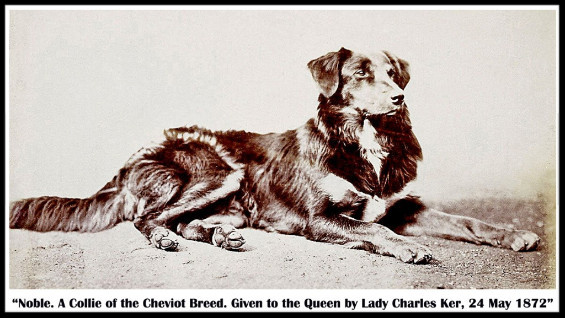by Vivian Flynt © 2015
Many dog experts describe dewclaws as a rudimentary fifth toe, a functionless, vestigial digit on the inside of the canine leg. I have to admit I bought into that description until last week, when our black-and-white English Shepherd, Jake, got a chicken strip wedged in his mouth. After our attempts to extract it proved futile, Jake reached into his mouth, snagged the treat with his front dewclaw and popped it out. That extra digit suddenly proved itself extremely useful.

Photo credit: Tom & Krystal Beers, Highland Glenn English Shepherds, WA Single dew claw. ~ Single dew claw
A dewclaw on the inside of each front leg is the norm in English Shepherds, as it is in all domestic dogs. While some ES breeders remove them when pups are “wee bairn,” other breeders insist the front dews stay, saying they work like thumbs and give the dog traction when making sharp turns, assist in the manipulation of bones or other objects, and provide grip when catching game.
The same is not said for rear dewclaws. Nowadays, the consensus is rear dews are of no value, especially when they lack the muscular control and firm, bony attachment the front dews possess. But history tells us such thinking was not always the case. At one time, for a goodly number of dog strains from the mountainous regions of continental Europe, double dewclaws on the rear legs were viewed as essential. Shepherds believed these working dogs’ double dewclaws provided stability and kept them from sinking too deeply into the rugged terrain’s snow and mud.
Interestingly, a strain of all-black or black-and-tan shepherd dogs with this same peculiarity existed for centuries in the high mountain kingdoms of northern Scotland, in the areas now known as Ross, Cromarty, and Sutherland. Developed in a time of large unfenced grazing areas bound by dense forests, Highland Collies worked cattle and native Scottish deer. To be considered a true Highland Collie the dog had to have double dewclaws on its hind legs.

Photo credit: Tom & Krystal Beers, Highland Glenn English Shepherds, WA Single dew claw. ~ Double dew claw
Sadly, the Highland Collie is now extinct. Beginning in the early-18th century and continuing for over one hundred years, British conquerors evicted Highlanders from their farms in an operation known as the “Highland Clearances.” Determined to integrate the comparatively wild Highlanders into the Kingdom of Great Britain, thereby eliminating Scotland’s clan system once and for all, common lands were enclosed and people were displaced from their traditional tenancies. Land that had been used for small-scale agriculture was given to Anglo aristocrats who converted it to sheep farming. Most of the sheep farmers came to the region from Britain. As they streamed in the Highlanders streamed out,emigrating to England, the Scottish Lowlands, and across oceans to North America, New Zealand, and Australia, taking their dogs with them.
Decimation of Scottish Highlander culture was the death knell to the Highland Collie strain. Fortunately for us, however, before the strain’s demise they contributed to the development of several modern-day herding dog breeds, including Great Britain’s Border Collie (when crossed with the working sheepdogs of the Anglo-Scot Borders counties) and modern show Collie (when crossed with Lowland Collies and Queen Alexandra’s Russian Wolfhounds). Highland Collies who immigrated to North America were absorbed into the English Shepherd (primarily on Eastern and Midwestern farms) and the Australian Shepherd (primarily on Western ranches).

From the days of the early settlers to as recently as the beginning of the 20th century, a strain of color-pure black-and-tan herding dogs lived in the Cumberland Mountains of Tennessee. Known colloquially as Mountain Shepherd Dogs, they sported double dewclaws. Perhaps still clinging to the clan system they’d been forced to abandon in their countries of origin, these American farmers wanted to preserve their sense of shared identity and descent. And part of that was the preservation of the old-style working dogs their Scot-Irish ancestors had brought to this continent. At a time when pedigrees mattered little, the main selection criteria included British Isles ancestry, usefulness around the farm, and a general old-collie look. History suggests the Mountain Shepherd Dogs were likely folded into the English Shepherd when it became a fixed-breed.
Which begs the question: Might the double dewclaws on today’s English Shepherds be a remnant of Highland Collie ancestry? The thought reminds me of 19th-century author Butler’s remark,
“’Tis some philosophers
Have well observ’d, beasts that converse
With man take after him.”
To think the shepherd dogs of the Scotsman’s croft, who shared their master’s taciturn disposition, strong work ethic, fierce independence and devotion to family, still live among us is humbling. It’s as though there was an ancestral pact between our two species that, no matter how much time, distance or adversity intervened, their common destiny could not be denied and they would always be together.
─ Author Bio ─
Vivian became enamored with English Shepherds in 1965. Starting in the mid-eighties, she bred sheppies under the It’za prefix. She now partners with William Clark as Botetot English Shepherds. In addition to having published the English Shepherd Advocate in the late-nineties, she has written numerous articles about the breed for various publications. Vivian lives in the Blue Ridge Mountains of southwestern Virginia.
SOURCES
Herding Dogs: Their Origins and Development in Britain by Iris Combe, Faber and Faber, London, England,1987.
Border Collies by Iris Combe, Faber and Faber, London, England, 1978.
The Heritage of the Dog by Colonel David Hancock, Nimrod Press, Hants, England, 1990.
The Complete Dog Book by The American Kennel Club, Howell Book House, New York, NY, 1992.
Shepherds of Britain: Scenes from Shepherd Life Past and Present from the Best Authorities by Adelaide L. J. Gosset, Benjamin Blom, Inc., New York, NY, 1972.
Highland Clearances, https://en.wikipedia.org/wiki/Highland_Clearances
Dewclaw, https://en.wikipedia.org/wiki/Dewclaw
Another Look at Dewclaws by Fred Lanting, http://www.workingdogs.com/doc0019.htm
English Shepherd Club of America Who’s Who Breeder Manual, English Shepherd Club of America, Quinlan, TX, Undated, 1953 or after.
The Dog Book by James Watson, Doubleday, Page & Company, Garden City, NY, 1912.